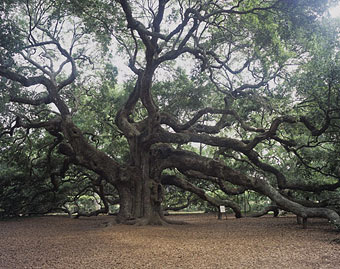
Angel Oak Park, Johns Island
Charleston, South Carolina
Angel Southern Live Oak Charleston, South Carolina
history continued
In 1988, led by Mayor Joseph P. Riley Jr., the City of Charleston sought to purchase the tree and surrounding five acres. The City wished to remove the fence, which had become dilapidated, and return public access to the tree. The City proposed to make the tree the focal point of a public park, do away with the admission fee, and place the health and care of the tree in the hands of the City’s Department of Parks As part of its commitment to retain the rural character of this area of Charleston, the dirt entry road to Angel Oak Park remained. The tree continues to be inspected monthly by the City’s Urban Forester and all maintenance is performed or monitored by the Urban Forestry Division or by contract administered by the City. Most recently, Charleston City Council initiated new preservation stipulations for the developable area adjacent to the Angel Oak. The City Council increased the buffer requirements surrounding Angel Oak Park from 50 feet to 150 feet. They further stipulated that, before any development would begin, the developer would be required to hire a consulting forester or arborist and a hydrologist approved by the City to produce a report indicating how the work would affect the Angel Oak.
The horticultural and arboricultural communities continue to be vocal allies for preservation of the tree. In 2000, the Angel Oak was named as South Carolina’s Millennium Tree by the America the Beautiful Foundation and, in 2004, the South Carolina Urban and Community Forestry Council named the Angel Oak as South Carolina’s first Heritage Tree. Professional certified arborists from all over the United States have volunteered to perform maintenance of the tree just for the honor of the association.
